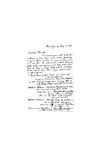Albert was born around 1860. As a child he was a regular attender at the Stratford New Year’s Day picnics. He won the book Robinson Crusoe in 1875 for his first place in the vaulting for boys under 14 years of age and a knife for coming first in the under 13 125 yards race. In 1876, Albert won the ‘boys’ vaulting under 16’. As an adult Albert played cricket for the Woodside team and in November 1886 was noted in the Gippsland Times as the team’s highest scorer.
Albert married Ellen (Looloo Looloo) around 1885 to 1886. They had a number of children, although only three survived to adulthood. They lost a number of children as babies, which would have been devastating for the couple. Albert and Ellen and their children moved from Ramahyuck station, to Lake Tyers and then onto Coranderrk, during the early 1900s. Albert was present at the marriage of his son Albert to Ellen Gibbs, which occurred at Coranderrk.
Rev. Hagenauer, manager of the Ramahyuck mission on Gunaikurnai country near Sale, wrote to Howitt in 1880 identifying Albert as a Bellum Bellum man of the Tarrawarracka tribe. Howitt included this information in his and Lorimer Fison’s 1880 book Kamilaroi and and Kurnai, although he queried the links between this and information he had been given by Tommy Hoddinot and a settler called Connor who identified an elder named old Darby as the headman of the Kut-wut and lived at Foster. Albert died in 1910, aged 51 years and suffering from ‘Multiple Tumour [sic] and Exhaustion’. He was living at Coranderrk Aboriginal Station, on Wurundjeri country, at the time of his death.
References:
‘New Year’s Day at Stratford’, Gippsland Times, p. 3, accessed 5 June 2020,
Albert Darby
http://nla.gov.au/nla.news-article61912632.
‘Yarram Yarram’, Gippsland Times, p. 3, accessed 5 June 2020,k http://nla.gov.au/nla.news-article62274779.
‘The Stratford Picnic’, Gippsland Times’, p. 3, accessed 5 June 2020, http://nla.gov.au/nla.news-article61909416.
‘Aboriginal Wedding’, Healesville and Yarra Glen Guardian, p. 2, accessed 5 June 2020, http://nla.gov.au/nla.news-article60189306.
Board for the Protection of the Aborigines, Twenty-Second Report, John Ferres Government Printer, Melbourne, 1886, p. 8.
Board for the Protection of the Aborigines, Twenty-Fourth Report, Robert S Brain, Government Printer, Melbourne, 1888, p. 9.
Board for the Protection of the Aborigines, Twenty-Fifth Report, Robert S. Brain, Government Printer, Melbourne, 1889, p. 8.
Board for the Protection of the Aborigines, Thirty-First Report, Robert S Bain, Government Printer, Melbourne, 1895, p. 7.
Board for the Protection of the Aborigines, Thirty-Second Report, Robert S Bain, Government Printer, Melbourne, 1896, p. 7.
Board for the Protection of the Aborigines, Thirty-Third Report, Robert S Bain, Government Printer, Melbourne, 1897, p. 7.
Board for the Protection of the Aborigines, Thirty-Sixth Report, Robert S Bain, Government Printer, Melbourne, 1900, p. 7.
Board for the Protection of the Aborigines, Forty-First Report, Robert S Bain, Government Printer, Melbourne, 1905, p. 9.
Board for the Protection of the Aborigines, Forty-Third Report, Robert S Bain, Government Printer, Melbourne, 1907, p. 5.
Board for the Protection of the Aborigines, Forty-Sixth Report, J. Kemp, Government Printer, Melbourne, 1910, p. 5.
Elizabeth Nelson, Sandra Smith and Patricia Grimshaw (eds) Letters from Aboriginal Women of Victoria, 1867-1926, History Department, The University of Melbourne, Melbourne, 2002, p. 329.
Alfred Howitt, ‘Notes on the Kurnai’, Papers of A. W. Howitt, Manuscript collection, State Library of Victoria, MS9356, Box 1053, items 3 (b) and 4(a), p. 90.
‘Yarram Yarram’, Gippsland Times, p. 3, accessed 5 June 2020,k http://nla.gov.au/nla.news-article62274779.
‘The Stratford Picnic’, Gippsland Times’, p. 3, accessed 5 June 2020, http://nla.gov.au/nla.news-article61909416.
‘Aboriginal Wedding’, Healesville and Yarra Glen Guardian, p. 2, accessed 5 June 2020, http://nla.gov.au/nla.news-article60189306.
Board for the Protection of the Aborigines, Twenty-Second Report, John Ferres Government Printer, Melbourne, 1886, p. 8.
Board for the Protection of the Aborigines, Twenty-Fourth Report, Robert S Brain, Government Printer, Melbourne, 1888, p. 9.
Board for the Protection of the Aborigines, Twenty-Fifth Report, Robert S. Brain, Government Printer, Melbourne, 1889, p. 8.
Board for the Protection of the Aborigines, Thirty-First Report, Robert S Bain, Government Printer, Melbourne, 1895, p. 7.
Board for the Protection of the Aborigines, Thirty-Second Report, Robert S Bain, Government Printer, Melbourne, 1896, p. 7.
Board for the Protection of the Aborigines, Thirty-Third Report, Robert S Bain, Government Printer, Melbourne, 1897, p. 7.
Board for the Protection of the Aborigines, Thirty-Sixth Report, Robert S Bain, Government Printer, Melbourne, 1900, p. 7.
Board for the Protection of the Aborigines, Forty-First Report, Robert S Bain, Government Printer, Melbourne, 1905, p. 9.
Board for the Protection of the Aborigines, Forty-Third Report, Robert S Bain, Government Printer, Melbourne, 1907, p. 5.
Board for the Protection of the Aborigines, Forty-Sixth Report, J. Kemp, Government Printer, Melbourne, 1910, p. 5.
Elizabeth Nelson, Sandra Smith and Patricia Grimshaw (eds) Letters from Aboriginal Women of Victoria, 1867-1926, History Department, The University of Melbourne, Melbourne, 2002, p. 329.
Alfred Howitt, ‘Notes on the Kurnai’, Papers of A. W. Howitt, Manuscript collection, State Library of Victoria, MS9356, Box 1053, items 3 (b) and 4(a), p. 90.
Found in Transcriptions
-
 Hagenauer to Howitt 1 May 1880Pages 1Registration Number XM188Author —Physical Description Letter, handwritten in ink. Signed and dated. One sheet, two pages. Condition: good.
Hagenauer to Howitt 1 May 1880Pages 1Registration Number XM188Author —Physical Description Letter, handwritten in ink. Signed and dated. One sheet, two pages. Condition: good.